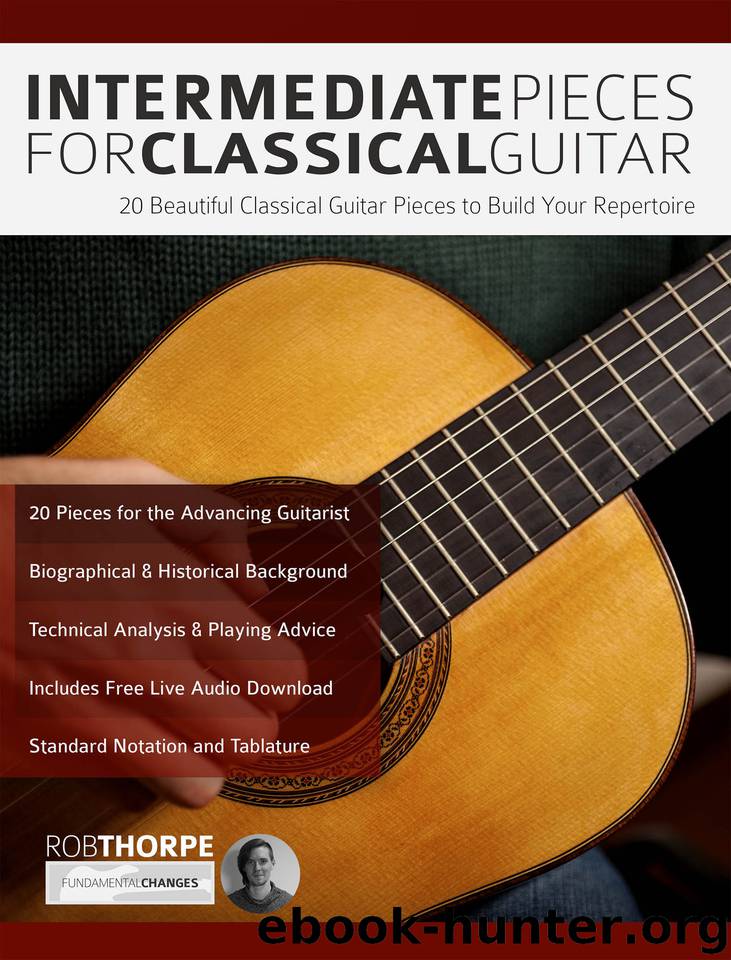Intermediate Pieces for Classical Guitar: 20 Beautiful Classical Guitar Pieces to Build Your Repertoire by Thorpe Rob

Author:Thorpe, Rob
Language: eng
Format: epub
Publisher: www.fundamental-changes.com
Published: 2018-05-01T16:00:00+00:00
Newport Fair – Rob Thorpe
11. Minuet in C from Sonata Op. 29 – Anton Diabelli
Continuing our exploration of different dance forms in 3/4 time, which so far has included the mazurka and waltz, we now have a minuet. It comes from Diabelli's larger Sonata in C for solo guitar, but is perfect to perform as a standalone single movement.
The minuet is characterised by the pickup beats into bars one, nine and onwards. There should also be a strong first beat in every bar, in contrast to the other two dances which emphasised beats 2 and 3.
Keep your first finger held down on the high C throughout the first four bars while your remaining fingers tackle the ascending bassline. Keep your thumb low on the back of the neck if you struggle to arch the fingers enough to avoid muting the high note.
The descending melody in bar five is a tricky moment in the piece. Developing the flexibility to stretch from the 1st to 5th fret may seem daunting, but will come with regular practice. Gently work on your fretting hand span every day after warming up.
An effective exercise would be to move the three notes much higher on the fretboard where the spacing is closer, and practise these pull-offs. When the stretch from, say, the 8th to 12th fret feels comfortable, work your way down towards the first position, taking several weeks to do so if necessary.
The slides in bars thirty-five and thirty-nine facilitate the position shifts and also add some tonal variety. Use your fourth finger in bar thirty-five, so the F bass note can be held down for its full duration. Slide the fourth finger up to the 5th fret, keeping enough pressure to sustain the note.
A common mistake is to rush hammer-ons, pull-offs and slides, and not give the starting note its full rhythmic value. Count evenly through these bars at first to ensure you're allowing the G at the 3rd fret to ring long enough, before sliding up quickly for beat one. Tapping your foot can help you to avoid rushing.
In bar thirty-nine, use your fourth finger again to prepare for the next bar, where you’ll use your third finger for the bass note on beat 1.
The form of the piece is that each section should be played with repeats in order, before returning to the top and starting again, then continuing to the Fine sign. After the D.C. the first two sections should be played again without their individual repeats.
I’ve added several dynamic marks to help you get more contrast out of the different sections. This will add more drama to the performance. Pieces from the Baroque period don’t often prescribe dynamics or tempo, as the performers were intended to interpret these themselves.
Download
This site does not store any files on its server. We only index and link to content provided by other sites. Please contact the content providers to delete copyright contents if any and email us, we'll remove relevant links or contents immediately.
The Goal (Off-Campus #4) by Elle Kennedy(13394)
Kathy Andrews Collection by Kathy Andrews(11695)
Diary of a Player by Brad Paisley(7427)
What Does This Button Do? by Bruce Dickinson(6111)
Assassin’s Fate by Robin Hobb(6072)
Big Little Lies by Liane Moriarty(5667)
Altered Sensations by David Pantalony(5019)
Pale Blue Dot by Carl Sagan(4873)
Sticky Fingers by Joe Hagan(4074)
The Death of the Heart by Elizabeth Bowen(3499)
The Heroin Diaries by Nikki Sixx(3466)
Beneath These Shadows by Meghan March(3239)
Confessions of a Video Vixen by Karrine Steffans(3216)
How Music Works by David Byrne(3098)
The Help by Kathryn Stockett(3056)
Jam by Jam (epub)(2997)
Harry Potter 4 - Harry Potter and The Goblet of Fire by J.K.Rowling(2955)
Strange Fascination: David Bowie: The Definitive Story by David Buckley(2773)
Petty: The Biography by Warren Zanes(2654)
